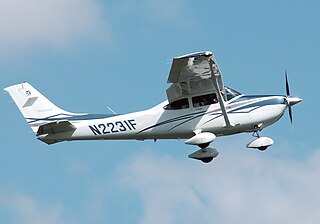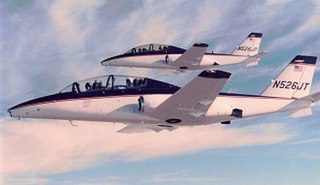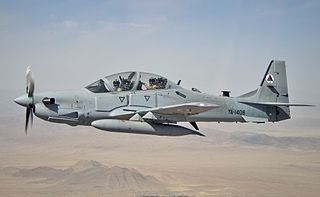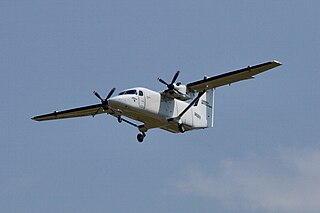Beechcraft is an American brand of civil aviation and military aircraft owned by Textron Aviation since 2014, headquartered in Wichita, Kansas. Originally, it was a brand of Beech Aircraft Corporation, an American manufacturer of general aviation, commercial, and military aircraft, ranging from light single-engined aircraft to twin-engined turboprop transports, business jets, and military trainers. Beech later became a division of Raytheon and then Hawker Beechcraft before a bankruptcy sale turned its assets over to Textron. It remains a brand of Textron Aviation.

Cessna is an American brand of general aviation aircraft owned by Textron Aviation since 2014, headquartered in Wichita, Kansas. Originally, it was a brand of the Cessna Aircraft Company, an American general aviation aircraft manufacturing corporation also headquartered in Wichita. The company produced small, piston-powered aircraft, as well as business jets. For much of the mid-to-late 20th century, Cessna was one of the highest-volume and most diverse producers of general aviation aircraft in the world. It was founded in 1927 by Clyde Cessna and Victor Roos and was purchased by General Dynamics in 1985, then by Textron, Inc. in 1992. In March 2014, when Textron purchased the Beechcraft and Hawker Aircraft corporations, Cessna ceased operations as a subsidiary company, and joined the others as one of the three distinct brands produced by Textron Aviation.

The Cessna 172 Skyhawk is an American four-seat, single-engine, high wing, fixed-wing aircraft made by the Cessna Aircraft Company. First flown in 1955, more 172s have been built than any other aircraft. It was developed from the 1948 Cessna 170 but with tricycle landing gear rather than conventional landing gear. The Skyhawk name was originally used for a trim package, but was later applied to all standard-production 172 aircraft, while some upgraded versions were marketed as the Cutlass.

The Cessna 208 Caravan is a utility aircraft produced by Cessna. The project was commenced on November 20, 1981, and the prototype first flew on December 9, 1982. The production model was certified by the FAA in October 1984 and its Cargomaster freighter variant was developed for FedEx. The 4 ft (1.2 m) longer 208B Super Cargomaster first flew in 1986 and was developed into the passenger 208B Grand Caravan.

The Beechcraft T-6 Texan II is a single-engine turboprop aircraft built by the Raytheon Aircraft Company. A trainer aircraft based on the Pilatus PC-9, the T-6 replaced the United States Air Force's Cessna T-37B Tweet and the United States Navy's T-34C Turbo Mentor during the 2010s.

The Cessna 182 Skylane is an American four-seat, single-engined light airplane built by Cessna of Wichita, Kansas. It has the option of adding two child seats in the baggage area.

Textron Inc. is an American industrial conglomerate based in Providence, Rhode Island. Textron's subsidiaries include Arctic Cat, Bell Textron, Textron Aviation, and Lycoming Engines. It was founded by Royal Little in 1923 as the Special Yarns Company. In 2020, Textron employed over 33,000 people in 25 different countries. The company ranked 265th on the 2021 Fortune 500 of the largest United States corporations by revenue.

The Cessna 400, marketed as the Cessna TTx, is a single-engine, fixed-gear, low-wing general aviation aircraft built from composite materials by Cessna Aircraft. The Cessna 400 was originally built by Columbia Aircraft as the Columbia 400 until December 2007. From 2013, the aircraft was built as the Cessna TTx Model T240.

The Cessna Citation Mustang is a very light jet that was built by Cessna. Launched at the 2002 NBAA convention, the Model 510 first flew on April 23, 2005. It received its FAA type certification on September 8, 2006, and was first delivered on November 22. Production ended in 2017 after 479 aircraft were built. The 8,645 lb (3,921 kg) maximum take-off weight jet is powered by two Pratt & Whitney Canada PW615F 1,460 lbf (6.5 kN) turbofans, can reach 340 kn (630 km/h), and has a range of 1,167 nmi (2,161 km).

The GippsAero GA8 Airvan 8 is a single-engined utility aircraft manufactured by GippsAero of Victoria, Australia. It can seat up to eight people, including the pilot.

The Cessna 162 Skycatcher is an American side-by-side two-seat, high-wing, strut-braced, tricycle gear light-sport aircraft (LSA) that was designed and produced by Cessna between December 2009 and December 2013. Its intended market was flight training and personal use.

The Cessna CitationJet/CJ/M2 are a series of light business jets built by Cessna, and are part of the Citation family. Launched in October 1989, the first flight of the Model 525 was on April 29, 1991. Federal Aviation Administration (FAA) certification was awarded on October 16, 1992, and the first aircraft was delivered on March 30, 1993. The CJ series are powered by two Williams FJ44 engines; the design uses the Citation II's forward fuselage with a new carry-through section wing and a T-tail. The original CitationJet model has been updated into the CJ1/CJ1+/M2 variants; additionally, the CJ1 was stretched into the CJ2/CJ2+ which was built between 2000 and 2016. The design was then further developed into the CJ3/CJ3+, built from December 2004 to present, and finally into the CJ4 which has been built since 2010. By June 2017, 2,000 of all variants had been delivered.

The Cessna 526 CitationJet was a twinjet trainer candidate for the United States Joint Primary Aircraft Training System proposed by Cessna. It was a twin-engined, tandem seat aircraft, based on the Cessna CitationJet executive aircraft. However, it was unsuccessful, with only two prototypes built.

The Light Attack/Armed Reconnaissance (LAAR) or Light Air Support (LAS) program was a United States Air Force program for a new light counter-insurgency, ground attack and reconnaissance aircraft. The aircraft should be capable of finding, tracking, and attacking targets either on its own or in support of ground forces. The program formally began in July 2009 with a request for information. No request for proposal has yet been issued. Approximately 100 aircraft were expected to be ordered, but USAF has reduced the number of aircraft sought to 15 aircraft. The 15 aircraft program was focused at training pilots, not a combat mission. This program has also been called the OA-X program or the AT-X program, although the reduced scope of the LAAR program has forced the USAF to push an "OA-X" program indefinitely into the future. In late 2019, the program received renewed attention by lawmakers, who expressed their frustrations with the program's pace. A group of legislators introduced amendments to the House and Senate versions of the FY 2020 National Defense Authorization Act that would transfer control of the program to the commander of U.S. Special Operations Command.

The T-X program is a United States Air Force development and acquisition program for a new two-seat jet trainer to replace the Northrop T-38 Talon. On 27 September 2018, the US Air Force selected the Boeing/Saab T-X entry to become its trainer aircraft. The new aircraft was given the designation and name "T-7 Red Hawk" in September 2019. The Air Force's initial plan is to purchase 351 T-7s, and has an option to purchase up to 475.

The Cessna Citation Sovereign is an American business jet developed by Cessna, part of the Cessna Citation family. Announced at the 1998 NBAA convention, the Model 680 made its maiden flight in February 2002, certification was awarded on June 2, 2004, and deliveries began in late September. The Citation Excel fuselage was stretched and joined with an all-new, larger wing and more powerful Pratt & Whitney Canada PW306C engines for increased maximum takeoff weight and a 3,200 nmi (5,900 km) range. The improved Sovereign+ was announced at the October 2012 NBAA for a first flight in April 2013 and deliveries in December, with added winglets and an improved flight deck and engines.

The Cessna Citation Longitude is a business jet produced by Cessna, part of the Cessna Citation family. Announced at the May 2012 EBACE, the Model 700 made its first flight on October 8, 2016, with certification obtained in September 2019. The aluminum airframe has the fuselage cross-section of the Citation Latitude, stretched by a seat row. Powered by Honeywell HTF7000 turbofans, it has a new ~28° swept wing and a T-tail for a 3,500 nmi (6,500 km) range.

The Bell 505 Jet Ranger X (JRX) is an American/Canadian light helicopter developed and manufactured by Bell Helicopter. The Bell 505 was unveiled at the 2013 Paris Airshow in June 2013 as the Bell SLS. The Bell 505 designation was officially announced in February 2014. Its first flight occurred on November 11, 2014. The helicopter was certified by Transport Canada in December 2016.
Textron Aviation Inc. is the general aviation business unit of the conglomerate Textron that was formed in March 2014 following the acquisition of Beech Holdings which included the Beechcraft and Hawker Aircraft businesses. The new business unit includes the Textron-owned Cessna. Textron Aviation sells Beechcraft and Cessna-branded aircraft. While no longer selling new Hawker airplanes, Textron Aviation still supports the existing Hawker aircraft fleet through its service centers.

The Cessna 408 SkyCourier is an American utility aircraft designed and built by Textron Aviation. It was launched on November 28, 2017, with an order for 50 from FedEx Express, with the aircraft designed for the needs of its FedEx Feeder service. It made its first flight on May 17, 2020, and was type certified on March 11, 2022. FedEx took delivery of the first production model on May 9, 2022.






















